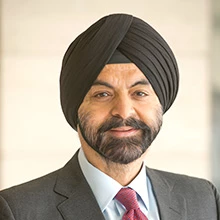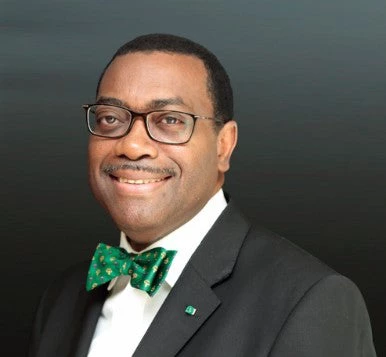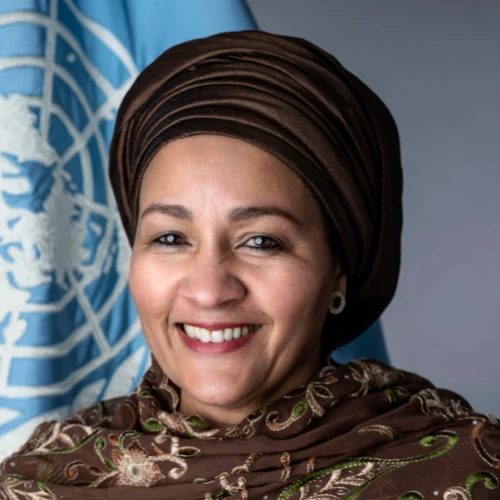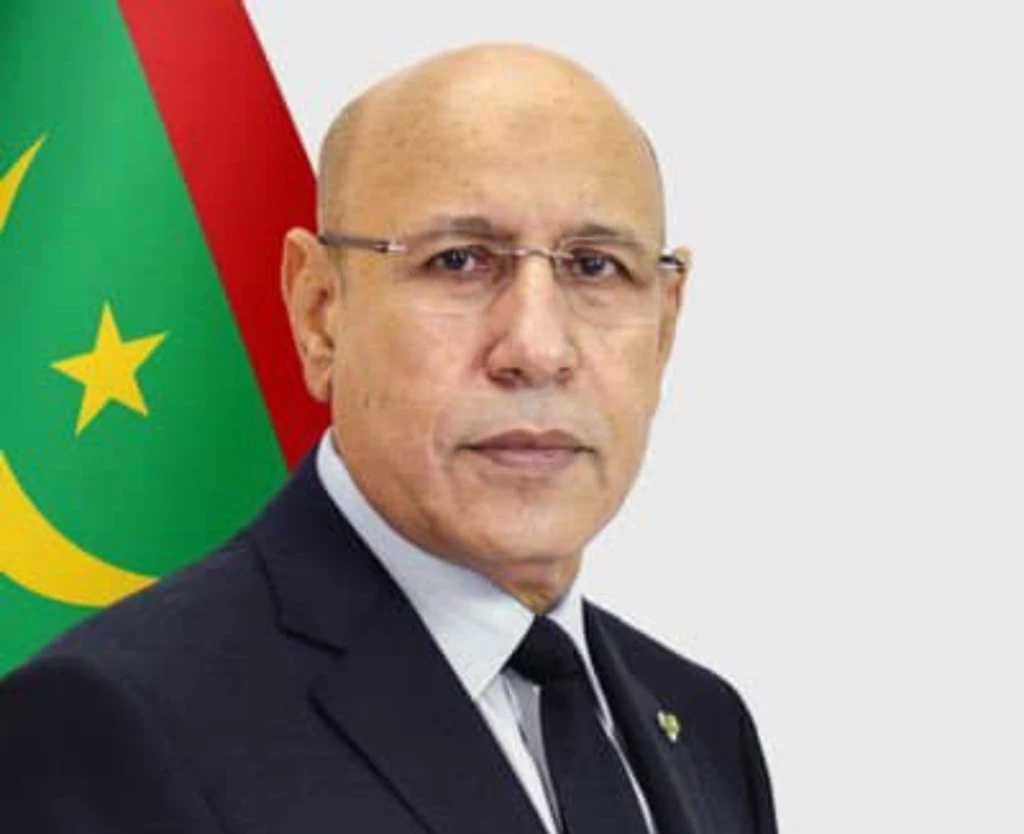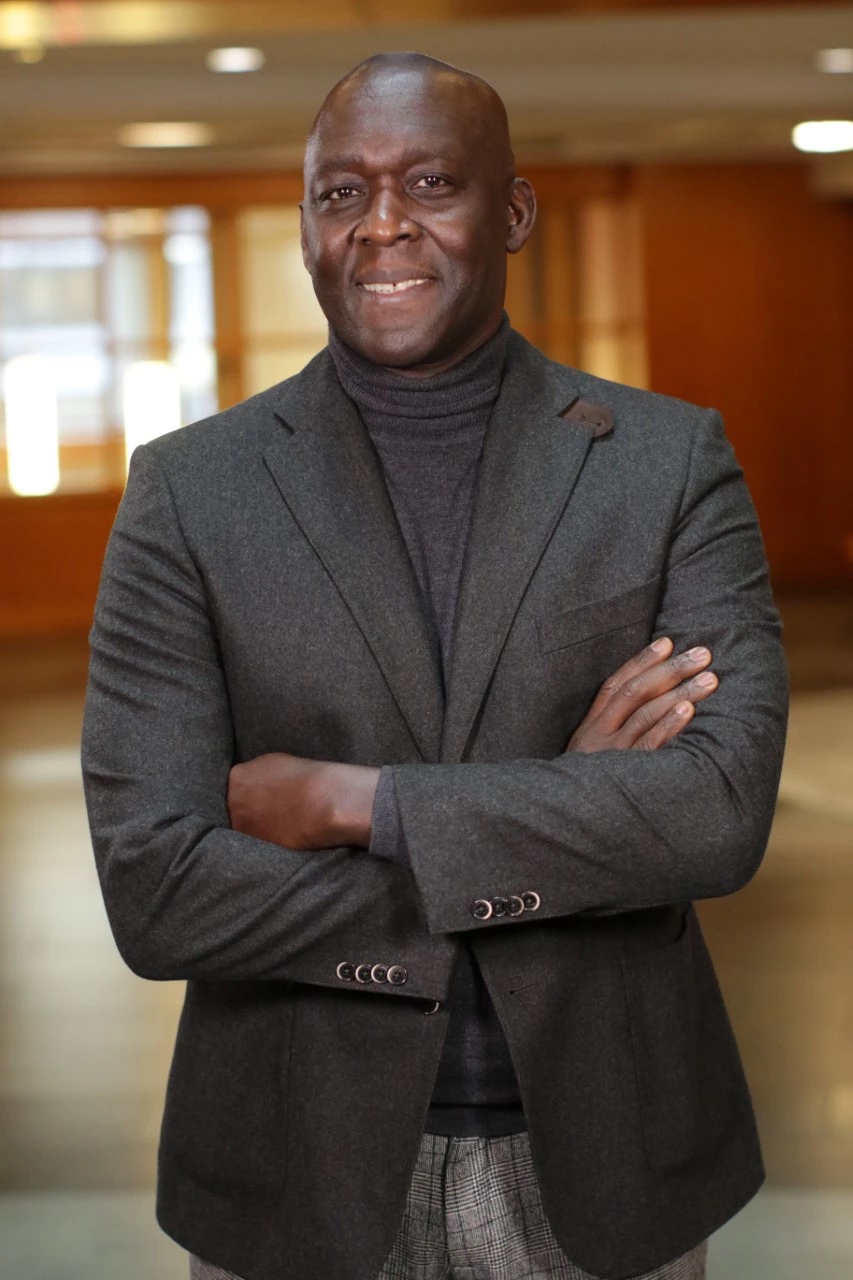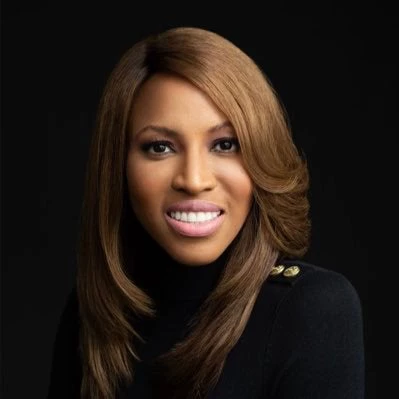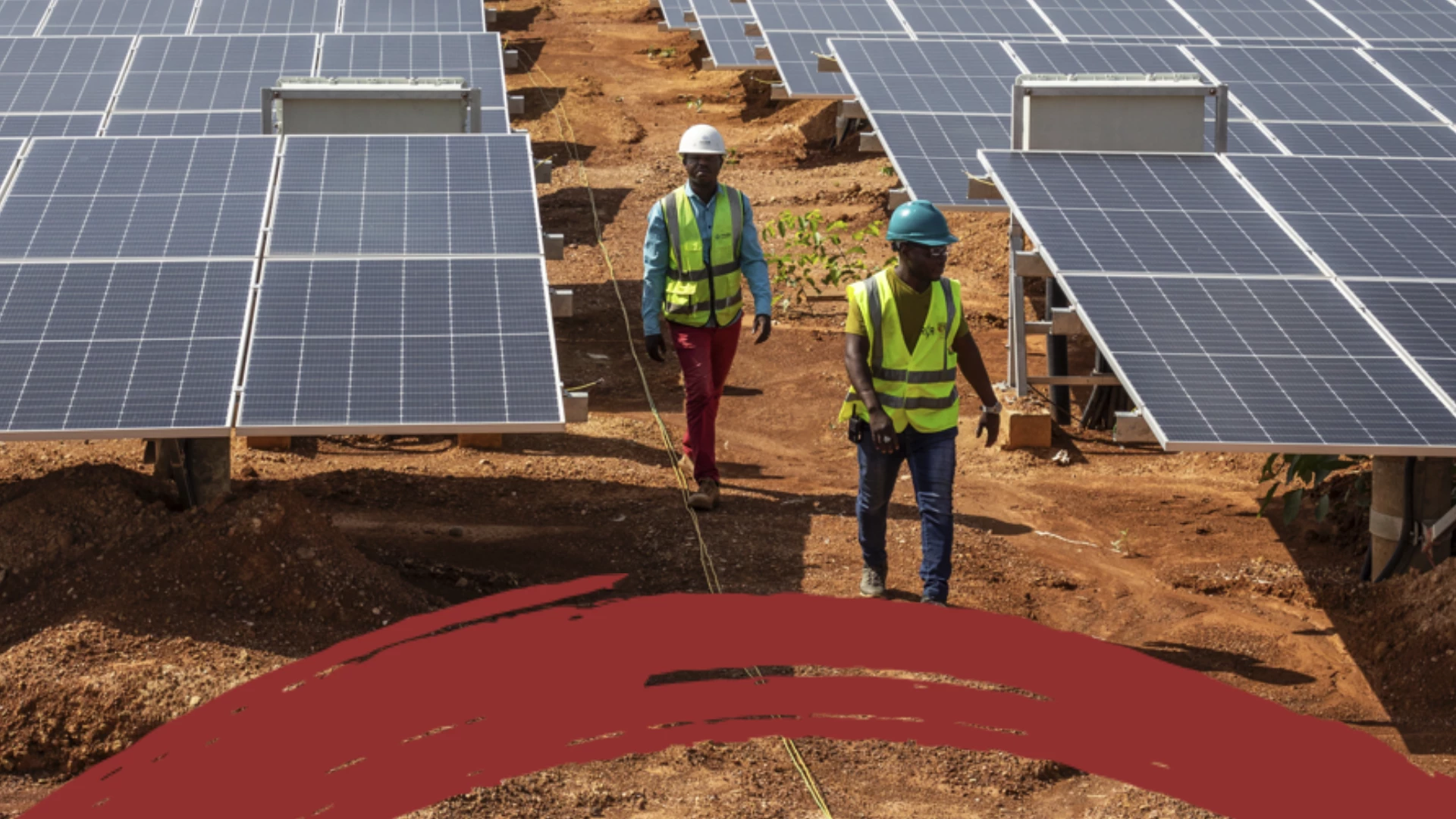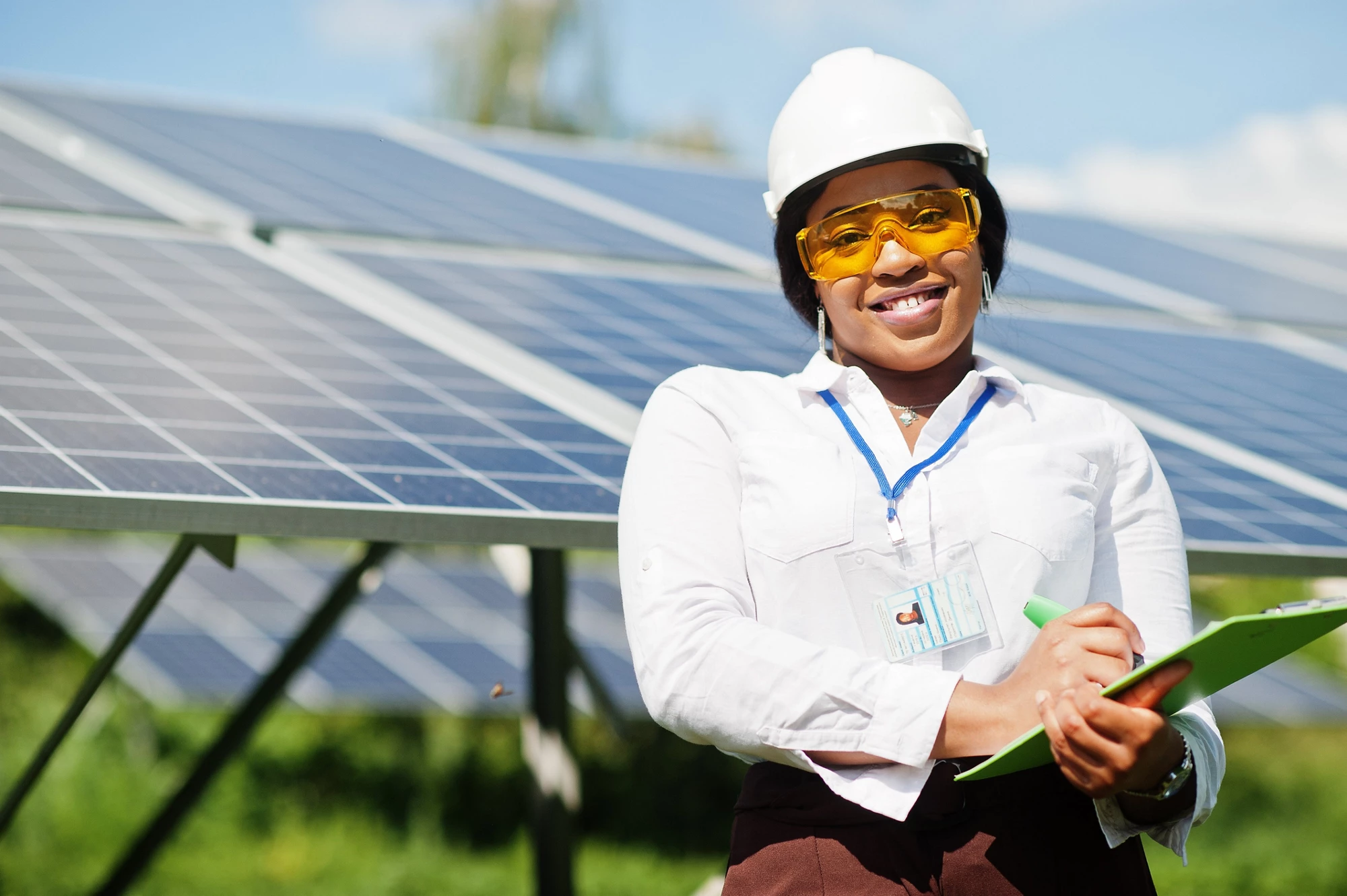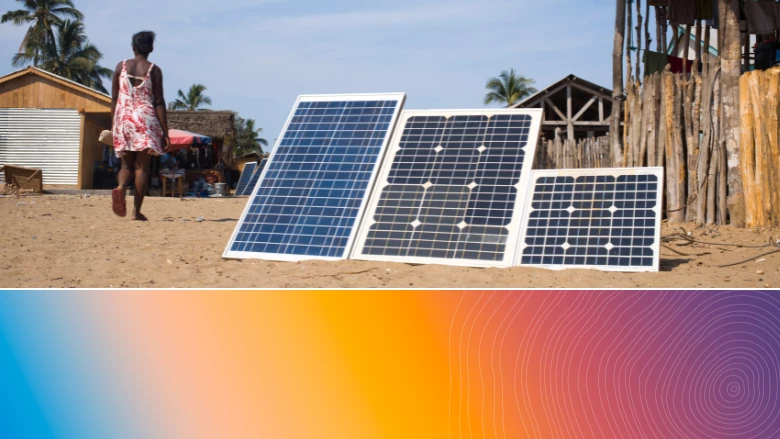WATCH REPLAY WITH CAPTIONS
[Linda Mabhena-Olagunju]
We’ll get straight into our panel discussion. I think we’ve had a lot of delays today. As mentioned, my name is Linda Mabhena-Olagunju, and I am the founder and CEO of DLO, which I’m proud to say is 100% black female-owned independent power producer operating in South Africa, and we own one of the largest wind farms in that country. Starting with you, Makhtar [Diop], I want to get a sense from you. We’ve seen a number of renewable energy programs being rolled out on the African continent, but even at that, we haven’t seen the uptake that we would like to see. Even in my home country, renewables currently account for less than 10% of the supply on our national grid. How do you see the private sector playing a more active role in terms of investment? What do you see as some of the challenges that have prevented a bigger uptake in renewable energy investments on the continent?
[Makhtar Diop] Thank you very much. I would like to thank all the head of states for their presence and leadership on this. If you allow me, I will step out of renewable energy and talk about electricity in general, because renewable energy is part of the story, but part of the story is not linked to renewable energy. I think that we are currently working towards accelerating. I think that we’re at an historical moment, and I think that this meeting will be certainly having a declaration [that] will be as important as the Yamoussoukro Declaration that you have in air transport or the Bamako Declaration that was held by the head of states on the health sector. We are looking at the three components of electricity production in Africa. We have generation, you have transmission, and you have distribution. I think that, if we want to reach our targets, we need to work on these three segments. On generation, I think that we have turned the corner, and I think that country like Nigeria and other countries have shown that, that generation is now mainly done by the private sector. If we are old enough to remember that there was a time where people were saying, generation should be done only by the public sector, it’s the strategic sector. We have turned the corner, and today, a big chunk of the production of electricity is done by the private sector. Now the private sector, it should be and it could be in financing this very expensive asset, which is transmission. I think the number one question for me, and the number of challenges that we need to address if we want to reach this target, is to bring the private sector in financing transmission. It means that in a lot of countries, we need to unbundle the system so that we can bring the local savings, the pension funds, the private investors locally, internationally, to finance this important, critical, essential asset, which is transmission.
The second one is distribution. A lot of the distribution companies are under-capitalized, are not in a good financial situation, and are therefore; not able to invest in operation and maintenance, which is so important. That’s why actually a lot of the power outages you have in Africa are not linked often to production. They are often linked to the distribution. The network is not robust enough to be able to distribute it. What can we do to improve the quality of the distribution companies? I would like to say that we have a time where we can change the paradigm. We need to have more investment equity. I will suggest that we open the capital of the distribution companies and we make it public. I think we need to think about a way to take the distribution companies and take them to a stock exchange. For me, that will be having many effects. First, it will allow the domestic savings not to fly out of the country, but to be invested in productive assets. Secondly, it will allow the pension funds and institutional investors to invest in it. The government can decide, depending on the decision of the head of state and the country, to give the majority or not to give the majority. But what is important is that we need to inject more capital in this distribution companies so that they can do what is needed. These are the three elements, and I think that we are seeing some movements. In South Africa, they’re currently discussing now the regulatory framework on how to bring transport, private sector investment in transport. Nigeria has been working also on this question, but a lot of other African countries. I think that, if we can take some of the discussion and try to see practically what we can do to be able to bring more private capital in transmission and more private capital in distribution, I think that we will be able to build on what has been done on generation and accelerating.
On generation, you have two components. The second component is to continue helping the country to clean their matrix. For that, for the most polluting part of their matrix, they can use transition resources like gas, gas to power, to substitute for coal, to substitute for heavy fuels, and all these very polluting sources of electricity while accelerating the production of renewables. I think that we have very good examples. I’ll leave it to some of our colleagues and clients we are working with here who have been investing heavily in renewables, are showing opportunities which are before us, and we are ready. Lastly, I would like to say an announcement, Zafiri, which is a new fund that we put in place to finance the decentralized renewable energy.
I would like to thank Raj [Rajiv] Shah and President [Akinwumi] Adesina because we are working together. It’s a very new approach. All these companies that we met need equity. They don’t have enough equity to invest in that sector. We are putting together a fund of 1 billion dollars to be able to finance this equity, where we will be taking a big part of the risk on the balance sheet of DFIs by taking the junior trench. We are receiving grant money from the foundations, like Rockefeller or other foundations, the money from IDA and the AfDB, and that we allow to get capital from those who are. I would like to say, and President Tinubu, I would like to announce that yesterday, you signed the first project using this facility for Nigeria, where yesterday we signed for 70 million of mandate to support this decentralized renewable energy. This is the journey for us, which goes beyond renewables, but includes larger renewables. I will let some of my colleagues here to talk about it because they are the ones who have been making this huge investment in this sector. Thank you.
[Linda Mabhena-Olagunju] No, thank you for that. That dovetails. That’s an excellent announcement because one of the big things we struggle with as entrepreneurs in the space, whether you’re dealing with transmission, distribution, or generation, is the issue of equity. If we look at what was said by the World Bank earlier on, we’re going to have to create jobs in the African economy. In order to do that, you are going to have to create local developers and local players. A missing piece is usually the equity check, especially for early-stage development for developers that are Africans, that retain the capital on this continent and that employ the Africans on this continent. But dovetailing to what you’ve already done is the IFC, I’d like to come to you, Aminu. If you could tell us a bit about the 500 million investment and partnership with the IFC on the distribution side. Could you tell us a bit more about that transaction and on what it means?
[Aminu Umar-Sadiq] Thank you. Thank you very much. I’ll just take a step back to perhaps offer a perspective, and then I can deep dive into that. I think following on from President Tinubu’s energy transition agenda, at the start of 2024, the NSIA and our coordinating minister of the economy actually conceptualized, developed, and operationalized renewable energy platform called Ripple. What that platform does is essentially address the value dislocations in the energy access sector. It does so by essentially being a developer, an investor, and an operator of a plethora of different kinds of projects, particularly around PV manufacturing, around franchising, which is essentially being a disco within a disco, and of course, diesel displacement. In the last 12 months, we have actually closed on two transactions, the first being a co-located solar PV farm alongside one of our hydro plants, as well as a PV manufacturing outfit in Lagos. As Mr. Diop mentioned, I think equity is the key in this regard, and I think this is what we offer through Ripple, but I think importantly, it’s also important to put the focus on local currency capital mobilization. The NSIA has done that through a facility called InfraCredit. Essentially, what this facility does is to mobilize local currency capital to domestic infrastructure, with a particular focus on distributed renewable energy. I’m proud to say that working with the World Bank and our coordinating minister of the economy, we’re also essentially establishing financial guarantor not only for DRE projects, but for large-scale infrastructure projects, particularly on-grade projects, transmission projects, and so on and so forth. I think, finally… [Audio cuts off]
[Aminu Umar-Sadiq] Alongside Africa50 as well as SEforALL, around a DRE-specific platform. The organizing principles around this platform are the following. The first is that it’s important to have a local manager tied in with a continental manager, NSIA being the local manager and Africa50 being the continental manager, to ensure that whatever key learnings that we essentially undertake in the course of implementing this DRE platform in Nigeria, we’re able to have the benefits of that as we proliferate across the continent. I think the second is around the capitalization structure. Equity is key, and I think that’s where NSIA and Africa50 are going to come in on the hard currency equity side, but also it’s important to attract equity on the local currency side, particularly for pension funds. We’ve been having discussions with the IFC around how to provide the requisite guarantees to actually mobilize local currency on the equity side for that platform. Then, of course, at the project level, you would have local currency debt. I think that capitalization structure is also extremely key. Then the third and final component of that platform is to make sure we take a whole of ecosystem approach. This platform, in and of itself, investing directly will not move the needle. But if we collaborate with financial sponsors like Chapel Hill Denham, like InfraCredit, who have a first loss capital in place, who have a deep pipeline of DRE projects in place, who are able to mobilize a foundation funds, but they lack the equity, this platform is able to finance that equity. Similarly, for financial partners and for operating partners who have bankable projects, who are able to access the debt but lack the equity, this platform would also execute upon that. I think a combination of these three organizing principles makes ourselves, Africa50 and SEforALL, with support from the IFC, excited that we can make a difference to this space. Thank you. [Linda Mabhena-Olagunju] Thank you. I want to dig deeper, though. Let’s unpack that a bit. At what stage is your equity coming in? Is it coming in when the projects are at 80% of development? Is it coming in at an early-stage development? Because once you reach 80%, you’ve already derisked your project and you can easily raise a check. What Africa is lacking right now is people who are ready to come in before we’ve actually achieved the early-stage permitting. If you’re going to unlock the potential of the projects that exist on this continent, we almost need an answer to the risk capital question mark at that early stage.
[Aminu Umar-Sadiq] Very good question. I think, of course, there’s a place for project preparatory facilities, and I think it is those facilities that actually address that. But equity, fundamentally, is in place to take exactly that risk. I think the focus of our platform would be not only Brownfield, cash-producing propositions, but also the very, very early stage at-risk development propositions. I think it’s only if we engage within that portion of the value chain that we will begin to make a difference.
[Linda Mabhena-Olagunju] Agreed. Patrick, you have had great success on the continent as TotalEnergies in terms of the renewable energy projects as well as other types of technologies, gas to power, etcetera. In South Africa, I think you’ve got a pipeline of 700 megawatts. Someone like you who has led this organization that has perceived success, what are some of the challenges you have faced developing projects on this continent?
[Patrick Pouyanné] Thank you. First, it’s an honor to be invited today. I’m happy to be with all of you, the head of states, Summit for Energy for Africa, for of course, obviously, for Total, which became TotalEnergies, it’s, I would say, our homeland, Africa. For oil and gas, we should not forget that oil and gas is today the bread and butter for many of these countries, but also for renewables. We embarked in a strategy where we want to do both and the renewable projects in Africa. I will be honest with you, yes, we have today 1.4 gigawatts have already operated or being built, but it’s not an easy journey. I think there are two, I would say, main challenges. I’ve already said that. The first one was mentioned by my friend of IFC, it’s the transmission system. When you want to build a renewable farm, you need to connect it to the grid. It’s a challenge in many countries, especially in Africa. Then you need to transport this electricity. It’s obvious that today when you have a distribution company which is managing both transmission and distribution, it’s difficult in term of huge capital to attract. I was discussing the issue yesterday with one President of Mozambique, where we have a large hydro project. I told him we cannot start the hydro because we don’t see the transmission line behind it. Frankly, we can attract, you can attract financial international investors, private investors on production like us on hydro, but you could also attract international and private investors on infrastructure. A transmission line is an infrastructure, but it has to be managed, as you said, by attracting more capital. Otherwise, I’m afraid this bottleneck will remain.
The second one, which is, I would tell you, even more important, is to be able to have a bankable PPA. What does that mean? But even my friend of IFC, they like to make profits like us. If you want to establish, when you are a renewable developer, you want to go to financing to banks, commercial banks, which all have a lot of commitments to develop renewables, green energy, plenty of hundreds of millions of dollars. What they want to be sure is that you need to secure the revenues of the project. It seems obvious, but you know that in this continent, they might have some difficulties of payments, local payments. We are asking for some form of guarantees. Guarantees, in fact, when you look to the project, there are not a lot of defaults. It’s just that the financial institutions they want some guarantees. Of course, we turn to the states, but the states, quite often, the IMF tell them, “Don’t give guarantees.” The IMF is a brother or something. Cousin from IFC. I think if it’s not the state which can give this guarantee, we need to have, and I think the World Bank CEO was there, but his representative, IFC is there, we absolutely need to have in place an instrument of guarantee for being able to develop all this PPA.
The international financial institutions have discussed it for years. Each time I’m participating to a conference, it’s now time to action. I hope that this M-300 that you launch today will be the opportunity to really have instruments, the World Bank, the MIGA, etcetera, but we need to have it because otherwise, honestly, I’m afraid we cannot put it at scale. The potential in the continent, not only on solar, but also on hydro is huge. So, this question of guarantee and financial institution or whoever it is, we should not be afraid. We don’t face many defaults. It’s just a question of comfort.
On TotalEnergies, we have done in some countries, in Iraq, but also in Libya, in Angola, try to make some links between all, I would say, all business and this renewable business by using, I would say, the proceeds which we got from oil as guarantee to renewables. It’s a solution which can work for us because we produce oil and gas, but it could not work for everybody. They could have some initiatives, and this is really a major point if we want to accelerate. I would say as well that, of course, and I would like to chime in, in Africa, it’s very important, in 2024, we took two initiatives. The first one is about clean cooking, and I praise President Samia of Tanzania. I think it’s very important, but when you speak about clean cooking, fundamentally, the easiest way to deploy clean cooking is LPGs. It’s back to gas. I know that there are some new methodologies of cooking, of cookstoves, but LPG is available in Africa. We committed the company to invest 400 million dollars to reach 85 million Africans with LPGs. If you combine these LPGs which are available, for example, in our projects in Uganda, we have a huge source of LPG, and we can use the LPG to deploy bottles, the LPG bottles, into Uganda, to all the neighbors in Tanzania and other countries. This is a very pragmatic way to bring this reliable energy and clean energy, because it’s much better than charcoal or wood. For women in Africa, it’s a huge progress. We are combining it, by the way, because one of the main topics is to make it affordable with some pay-as-you-use tools, with digital tools, in order for a customer not to be obliged to pay upfront the full bottle of LPG, but to pay when he’s using the LPG bottle, which is one of the other challenges as well. This is the first initiative we took, 400 million dollars to deploy this LPG’s clean cooking invest into some storages and distribution of LPGs in the continent.
The second initiative we took is that we observed with other large corporations like mine, my European colleagues of BP, Equinor and Shell, we speak about a lot in Africa about micro-grids or home solar. It’s quite difficult. There are plenty of SMEs we try to deploy, and we honestly feel that we are not really progressing well. We decided to put all our efforts together in a new fund, which will be allotted by 500 million dollars, which will be managed by a private equity fund in order to invest and to really have a capacity to really bring more to this development of home solar system, micro-grids, etcetera. It’s not easy, but we think that all what we can do to develop access to energy, to the African population is important. Last part, again, is gas. I know you’ve asked me a question about renewables, but if you want and you need in Africa, electricity, but you want a 24/7 reliable electricity, when you have intermittent sources like solar and wind, of course, you have some hydro. You need to combine it with gas-fired power plants. I know there is a debate, but I’m fully supportive of all of you here. You need to speak up in all the international arenas, including with my European friends, that, yes, it’s true that climate change is fundamental, but gas will allow you to make some progress. It will allow you to develop Africa. It will allow you, in fact, to give economic development, social development, it’s the best way. Gas to power has to be developed in the countries. Again, I was in Mozambique. We have a huge LNG project to develop in Mozambique, but somewhere, of course, very legitimately, the authorities of Mozambique are asking us, “What can you do for domestic gas?” Domestic gas means, in fact, power. Gas to power. I think it’s a good argument. I think with the other countries, and European countries, tell them, “Look, you want us to export our LNG to Europe because you don’t have the Russian gas anymore? We should be allowed to develop our gas also for our own economy.” So, I’m a big advocate, and I think we are aligned with IFC gas to power, transmission, and again, finding a way to guarantee renewable CPAs are the three, I would say, topics on which I think if we want to make this Mission 300, really a reality, we need to work together.
[Linda Mabhena-Olagunju] Thank you, Patrick. I think you really touched on key issues, especially around the turnaround time. Whenever there’s a lack of a government-backed programs. For example, where there isn’t a government-backed or government-guaranteed program like we had in South Africa, when you are pursuing PPAs, it is a very long and arduous road, and that doesn’t build a market. I remember when Hussain, your company started its track in South Africa, your business development lady, Barbo, used to come and knock on doors and say, “I’m from this company, AMEA Power,” and I was really happy to see, finally, you guys won a project. No one talks about how long it takes to actually get to the point of being a successful bidder in these programs, but also the fact that we need to de-risk these projects significantly, whether you’re doing power, whether you’re looking at the infrastructure side, which is your transmission. Could you tell me a bit about your journey as well in terms of what you see as a challenge as an investor in Africa in the power sector, and in particular, the role you feel guarantees play in de-risking these projects for you as an investor?
[Hussain AlNowais] Thanks, Linda. I think my three friends on this panel have covered a lot of the points related to this, but let me share my personal experience. My company, AMEA Power, has been around for eight years. We are today present in 20 different countries in Africa. We believe in Africa. We were an early believer in Africa. We believe in this great continent. We believe in the people of Africa, and therefore, we have committed fully to this continent. We’re in about 6,000 megawatts today in these 20 countries. The challenges we saw are the same challenges raised. The first big challenge is the grid. My brother Makhtar highlighted that. I think it’s about time for the IPP developer to start investing in the grid. My company, AMEA Power, have decided to pursue this route, and we want to discuss it with potential clients in Africa because they are unable to do the grid. We see generation is easy, but you need to evacuate that generation. How can you evacuate if there is no grid or there is poor grid? Some countries, like Morocco, have done a great job by investing in the grid. Egypt have done a great job in investing in the grid, and that has eased the job for developer to start building generation. I think some of my other friends in different countries, I see many great presidents of Africa here, one needs to start opening that grid for the private sector. It will help them, it will create another avenue for generation. The second challenge we see in some countries is the convertibility of the currency. In our principle, we always need to be paid in a currency of convertibility, dollar or euro. Some countries, like South Africa, because you are able to borrow in rand, you hedge your risk on the currency. Morocco, you borrow in dirham because you hedge yourself in currency. Other countries, we cannot. We cannot accept it. It has to be convertible currency, and it has to come with a bankable documentation for the project. That was raised by our friend. The bankability of these documents is important because we all go to the lenders, and the lenders will stake minimum risk and pass the risk on you as a developer. From our experience, we believe the challenge as well is the permitting and dealing with the different local organizations. Therefore, one of the suggestions I’ve made to some of the friends in the government in African countries is to have a one-stop shop where we, as a developer, deal with all the required permits, be it land, be it taxes, be it whatever permits or dealing you need to have with government agencies, a one-stop shop. The investor doesn’t waste time running around. It’s there. You go and deal with all these issues.
We’ve seen this, for example, in Togo, a small country where they have done it remarkably very well. You go to the one-stop shop, all the issues are solved, and you move on. We delivered in Togo, for example, in 14 months, from A to Z, in a challenging time. Why? Because we committed, and because the system allowed us to do so. We also believe, which makes life easy for us in the community we work on, we work on communities, which are normally remote, is to partner with that community. By that, I mean we invest in their needs. We build clinics, we build schools, we hire their young men and women, we train them, we develop them to become part of the team who operates this plant. That community partnership has eased life for us. Some of these countries, the rural areas have a challenge of security, have a challenge of all kinds of challenges. What we did in a particular country, I don’t need to mention, we had challenges there. What we did, we went to the community and offered them all the services they needed to make their life better in their community. It’s part of the cost we took on our shoulder, but it made life so easy and so successful, we were able to finish on time, on some cases ahead of schedule. These are lessons we learned in this journey of developing power in Africa. Obviously, some countries are more advanced than others. Some countries have more capacity than others.
By the way, speaking of capacity, that’s another important thing. Sometimes you sit across the table from a client. That client is not familiar with the rules and the regulations which are needed for investments. We as an investor, we need to have bankable documents, we need to have currency protection, we need to have sovereign guarantee because I need to go to my friend in IFC and say, “Can you lend me money?” Or my friend in AfDB, “Can you lend money on this project?” They will say, “Okay, what are the guarantees you have?” These are very, very important. Otherwise, you don’t have a bankable project. Otherwise, there is no project. Now, my friend in Total is lucky. If there is oil, he has the security of that oil and can do it, but others, we don’t have that privilege. I’m a strong believer in the potential of this continent. I’m a great believer in the people of this continent, but we all need to work to provide coaching for capacity building for the resources on the other side of the table.
[Linda Mabhena-Olagunju] No, thank you. That’s very, very well said. I think just to wrap up from the deliberations from this past two days. As the private sector, we’re being called upon to invest. I think it’s also very important because this is one of the first conferences I’ve attended where you actually have the presidents and the decision-makers sitting and listening to private sector. I think this provides a unique opportunity for us as private sector to say what needs to be done, which you’ve touched on about accelerating the rate at which permits are being given out in order for us to be able to develop these projects faster. Patrick, you’ve also touched on issues around financial guarantees that need to be in place in order for us to be able to lend the money in order to get these projects off the ground. The one thing I think that was not really touched on throughout the two days of the Summit is there was a lot of mention on jobs and that we’re going to create these jobs. To create jobs, you need to have scale. To create scale, you need to have volumes of orders, as we know. If we’re only rolling out a megawatt here, that’s not enough to sustain manufacturing on a sustainable level. If we are really going to be serious about this target of 300 million in the next five years, what are we thinking around building the local manufacturing or assembly capacity on this continent to create those jobs? Because those jobs don’t come from generation alone. I remember Total had an assembly plant in South Africa, which unfortunately didn’t have enough volumes due to our stop and start approach at the time. I think it’s important to be clear to the leaders in this room today that the jobs will not come from generation alone, and we need volumes in order for us to be able to produce the scale that can sustain a manufacturing base. I don’t know if you have any other comments around that as we wrap up on your observations over the last two days.
[Hussain AlNowais] If I can just say one thing on the scale, I totally agree with you, by the way, on the scale. I was having a discussion with one of our friends today from the government in North Africa on the tariff. Now, I cannot provide a low tariff on a 30-megawatt project. You cannot compare a tariff I made for a project of a 1,000 megawatt with that of 30 megawatts. Economy of a scale, and procurement, and construction makes all the difference. Now, the challenge some countries have on allowing an investor like us to build, we’d like to build big projects. I built today in Egypt, I’m building the largest single power project in African continent. It’s 1,000 megawatts in one site. The challenge is that the grid, because these are remote areas, they need to build in that village, and this village, and that area, near this mine, near that industrial zone, but there is no grid; and therefore, you only have 30 or 40 or 50 megawatts, and you connect accordingly.
[Patrick Pouyanné] At the end, and we face the situation. It’s an industry which is dominated largely by one or two countries. All of you at the end, the objective for head of states, Europe, Africa, is the cost of electricity for the customer. Today, you have to be efficient. I think in the solar industry today, almost 90% is produced in China. The question we have is, can we convince the Chinese company to come and to manufacture? For that, we need to have enough. The size is fundamental. We are managing today to develop an alternative to China in India, but we are engaged there, TotalEnergies, in a 30-gigawatt project. So, solar and wind, 500 square kilometers, it’s huge, but it gives, of course, this manufacturing industry a way to take off. The question, as you said, is, do we have enough scale? Honestly, I perfectly understand the very legitimate request, but then at the end with the arbitration between a local manufacturing, which might be more expensive, and the cost of electricity for customers. We are not yet there, I think. There is one country where we think we could have a scale. It’s your country, South Africa. The other one is Egypt. Because these are the two countries, and Morocco, so three countries, I would say, where we’ve seen, and recently we signed an MOU to develop a large, very large farm in Morocco to produce hydrogen or electricity, we’ll see what it is. But the scale is fundamental if you want to reach your objective. To be honest, even Europeans do not manage to make manufacturing. I don’t encourage you to make tariff to get local jobs, be careful. It’s not the solution to the planet and to develop more electricity, in particular in this continent. By the way, I just touched upon one point. I think there is a way for all the countries in North Africa, Morocco, Algeria, Tunisia, Libya, and Egypt, to look to it to Europe, as a green deal, as a huge market for electricity. We will never manage, I can tell you, because of lack of space in Europe. We have a problem of access to land. We will never manage because... And the weather, by the way, it’s more sun in Africa than there. We will never manage to reach the objectives of the green deal without finding a way to develop large and efficient renewable farms in these countries and to link them by subsea cables to Italy, to Spain, to France. It could be a source of revenues for Africa. If really, we are serious there, this is something on which we are working today with different countries. We have engaged a company, something which is a little landing on the moon project, which is called Xilinx, but this is the idea. We need to develop that and this could be a resource. The other comment I would say, don’t forget hydro in Africa. Hydro is not intermittent. You have still a potential. We acquired this last year in ‘24, we are just closing it. All the developers of hydro projects of Scatec, Norwegian company, in Uganda, Rwanda, Malawi. There is Gabon, I could say. There is a good potential, which is maybe easier to access because it’s less intermittent. So, giving a new, more pragmatic solution, but you have a big potential in hydro in the continent.
[Linda Mabhena-Olagunju] Thank you very much. I’ve been told and threatened that our time is up. Go ahead.
[Makhtar Diop] Just I want to come back to what we started with, because I think we have the head of states who are here and who are expecting us to give us some ideas of what they can work on and bring their government to work around. I think that things are happening. For instance, in Mauritania, on the mining side, there are huge investments needed in electricity. We are working with Mauritanian authorities. I want to come back to say that for me, the main bottleneck right now would be transmission and distribution. What Patrick have just said about connecting submarine cable to Europe is transport and transmission. But you can go further because Morocco and North Africa will be connected to Mauritania, will be connected to the Sahel, and also then export the huge capacity of production that existed in renewables. If we don’t address this bottleneck of transport, I think we are missing a big opportunity of growth, a big opportunity to increase access. I think that one of the takeaways here will be, can we have an agreement or commitment that we will be unbundling transmission and accept to have investment from the private sector on transmission? This is a political decision that needs to be [taken]. Secondly, we cannot do M-300 if the utilities are in the current financial situation that we have in a lot of African countries. I spent, personally, a lot of time in my career working on this. I think that if you don’t address the financial sustainability of distribution companies and their governance. The financial situation is often linked to the governance. To address this, your governance, we need to make the capital open to the public. We are talking about capital flight in Africa. I don’t believe that African people want to put their money abroad for the sake of doing it. If they had the opportunity to invest in assets which are tangible, interesting assets where they can make money, the middle class in Africa will invest in shares, in the utility if the utility functions well. There, we’ll be able to take the savings of African people and transfer them in productive sectors. I think there is an agenda, short term, that we can work on address to be able to accelerate what we are doing right now, and on the DRE to be able to do on renewables. Lastly, guarantee is well heard. We are quadrupling the guarantee of the World Bank Group. That’s part of the big reform of the World Bank Group. We are doing 30% of our lending in local currency right now at IFC, and we are aiming at doing much more in the future. I know that the time of the head of state is very precious.



